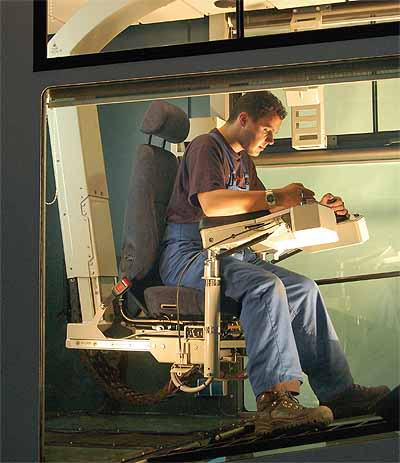Merford Produktie
Metford is in the driving seat
Merford Cabins is part of the Merford Group and develops, produces and supplies high quality operator cabins and cabin components for various types of cranes, specific vehicles, machines and installations all over the world under the brand name ERGOCAB. Besides cabins, Merford specialises in noise control and climate control.
“Our philosophy is to create an optimal working environment for our client’s employees,” says Daan Potters, general manager of Merford Cabins. “We specialise in ergonomic solutions to prevent illnesses and injury.”
He continues: “Comfort improves motivation, while safety and good ergonomics reduce the number of persons who are injured at work. I firmly believe that a pleasant and ergonomic working environment improves the well-being and performance of staff, as well as the efficiency of a crane, vehicle, machine or installation.”
A question commonly asked by Daan and others at Merford is ‘are humans made for sitting?’ The answer quite simply is no, yet most crane operators have to sit for many hours a day in awkward positions, often without the right tools or instruction. This can cause discomfort and serious injury.
Daan, who is focused on improving working conditions, explains why: “For all container cranes, the field of vision is vertically downwards and this adds an extra challenge of getting people seated correctly, in positions that won’t damage their back or neck.”
Besides looking downwards, all types of container cranes have specific, individual characteristics. For STS cranes, for instance, high accelerations and decelerations forward and backward, the shocks at the boom junctions and the impact of a possible E-stop all impact operator well-being.
The typical problems a RTG driver faces are also highly underestimated. The fields of vision are different compared to an STS crane, so looking around while driving the machine places a huge strain on posture. Because the spreader is closer to the cabin, spread legs are often an obstruction and the side-windows commonly used to look at the corner-castings. Additionally, sideward movements in combination with rubber tyres give the machine and the driver a swing during start and stop.
A similar situation occurs with Straddle Carriers. However, the speeds are higher and the sitting position is often perpendicular to the driving direction.
It is believed that unmanned equipment best solves these types of problems. But the question remains whether this is a practical scenario for container terminals around the world. At present the answer is a definite no and manned cranes will be in demand for at least the next ten years – maybe more. As a result, in order to prevent fatigue, physical pain, loss of efficiency and dangerous situations, several circumstances – such as the working posture in STS, RTG and RMG Cranes, as well as the ISO Standard 11226 ‘evaluation of static working postures’ – must be examined. In doing so, companies like Merford conclude that crane drivers require full support and are dedicated to creating ways of providing such support.
In the last decade, Merford has invested considerably in developing solutions for the problems mentioned above. Together with crane drivers, engineers and managers of container ports, scientific institutes and industrials designers, several products have been launched and successfully introduced by Merford. The Ergoseat for STS cranes is perhaps the best-known example.
Talking about Merford’s investment in innovative solutions, Daan continues: “Innovation is essential. We wish to maintain growth and to do so we need to continue developing the products and solutions required by the market. To achieve this we invest considerably in research and development. This investment has enabled us to introduce numerous new products, ideas and approaches to the market place. End-users are delighted with our innovative thinking, unique philosophy and customer focus, as well as quality, which is essential of course.”
Never afraid to think outside the box, Merford will unveil a new cabin and matching seat arrangement specific for RTG and RMG cranes during TOC 2007. Merford is also currently doing tests, in close co-operation with ECT Rotterdam, on the revolutionary MDS. It is proven by scientific research that this system prevents and reduces lower back pain and fatigue caused by prolonged sitting. This product will be suitable for all types of industrial equipment as it is easy to build into even existing crane seats.
Looking to the future, an excited Daan concludes: “Our goal is to bring the company into a position where we will be able to offer greater support to our customers. Currently, within industry, a lot of customers are losing experienced workers, people that are almost impossible to replace.
Consequently, they are now subcontracting more than ever and looking for suppliers to replace the knowledge and skill base they might have lost. If we are to tap into this lucrative market and enjoy yet more success in the future then we have to evolve from a company focused on production to become a company focused on service and problem solving. We already have the knowledge, skill and proficiency; we merely have to adjust our focus. This is our main area of development.”
Merford Produktie
Products: Operator cabins and cabin components
Sites: Groot Ammers, Holland
Employees: 200
www.ergocab.com
